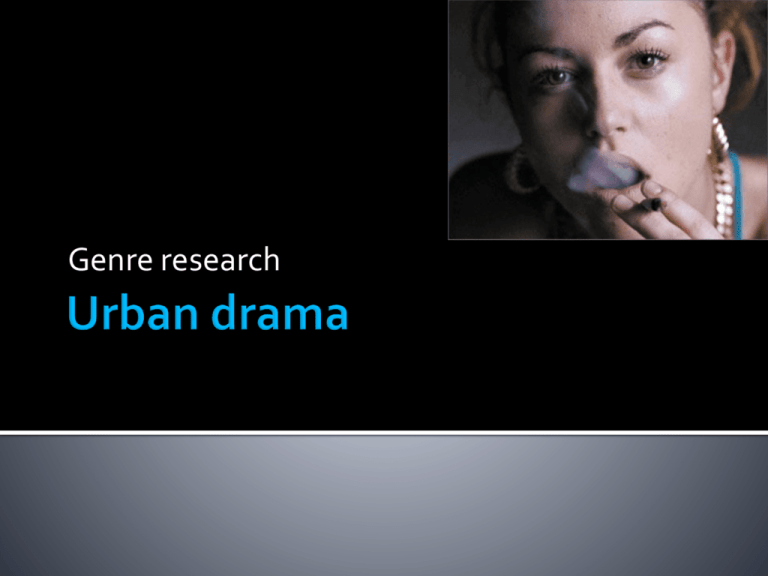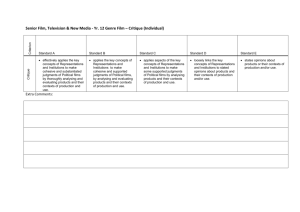Abena genre research (urban drama)
advertisement

Genre research The urban drama genre focal points are on issues that tend to surround our modern society and contemporary urban lives. Sometimes in these films city are almost personified to give an impact on its characters, usually the protagonists. Many topical issues are aroused to show how the characters can be affected, like corruption, race, culture and chaos. The urban drama genre is somewhat a contemporary version of the gangster film genre, hence its history can be related back to the early 1930s where the release of such films like Little Caesar(1930) and Public enemy (1931) were positively acknowledge for success. Gangsters did not have a sense of literary about them like cowboys or detectives, however they appeared on several contemporary newspapers as the front page headlines. Likewise, the use of strong topical issues placed a great impact on its audience as they were able to relate to the situations in which were occurring in the gangster films. Consequently, urban drama are focuses on the everyday issues within our contemporary society. What became predominantly known in the 1930s as gangster crime films was not essentially the first time a film of this type was made. In 1912, The Musketeers Pig Alley exploited an urban-based crime topic for its storyline. Additionally, The Racket (1927) and Underworld (1928) discretely laid down an establishment for the urban/gangster genre. Furthermore, as people moved from the country to cities there was an influx of fascination towards the urban genre. Moreover, the urban genre continues to be on the rise as the video market for urban movies is acclaims superiority. DVD Consumers are finding independent urban movies more appealing. ‘Filmmakers are pushing the complexity and overall look of the urban genre to new levels.’(as quoted on buzzle.com) Film director behind the urban movement include: Craig Brewer Charles Dutton Damon Dash Sid Kali Hype Williams John Singleton Dale Stelly Mike O'Dea The Hughes Brothers The Crook Brothers Quentin Tarantino. Kidulthood •Released in 2006 •Directed by Menhaj Huda Bullet boy •Released in 2004 •Directed by Saul Dibb Shifty •Released in 2008 •Directed by Eran Creevy Juice •Released in 1992 •Directed by Ernest R. Dickerson Stomp the yard •Released in 2007 •Directed by Sylvain White Boyz n the hood •Released in 1991 •Directed by John Sigleton As the urban genre tends to revolve around a contemporary society there are a lot of generic conventions when it comes to mise-en-scene. Location/Setting Council flats City streets Corner shops Back alleyways Lighting Dark- the scenes which are meant to be more obscure occur during the evening, so that the protagonists do not get themselves involved with the law, ideally police. Light- some conflicts occur during the day to show that the protagonist are rebellious when it comes to doing things they know is not morally or lawfully acceptable. Props Guns Knives Baseball bats Costume and make-up School uniform Urban clothing- hoodies and caps Promiscuous clothing- short skirts, tight tops Colour A variety of colours are used to accentuate a sense of realism Dark colours- black and blue bring a sense of severity amongst the characters Character position There is usually an ensemble of characters shown together to emphasise friendship and rivalry amongst different friendship groups. Vulnerability is emphasised if characters appear solely. Camera shots Significance How can we incorporate them into a trailer? Tracking shot •Closer affinity with moving characters •When a character is being chased by the antagonist this type of shot can be used so that the audience is able to keep up with the pace at which the character is running. Close-up •Emphasises emotions to evoke audience meaning. • When a character is contemplating on his/her actions this shot can be used, especially in times of sadness when the audience are may to feel sympathetic towards them. Crane shot •Highlights times of vulnerability by looking down on a character • This has been incorporated in such films as Kidulthood, where the shot is taken from a higher level on a estate flat. This possibly give a sense of inferiority to the character who is position on ground level or superiority for the character above whom is looking down on something. Wide shot •Allows the audience to see how characters may react to their surroundings or to one other. •The streets of London can be recognised through this shot most clearly, however the focus of the character is not lost as we can see how he reacts to his/her surrounding. Over-theshoulder shot •Allows the audience to be in the perspective of the character. •This can be incorporate to put emphasis on a friendship, like shown in Shifty. As a hug symbolises unity, the over the shoulder shot is used to capture a moment in time were two friends may be showing platonic affections. Two shot •Emphasises the importance of friendship in certain cases. • A platonic relationship or intimate relationship can be used to incorporate this shot, as shown in Boyz n the hood. Conversations are usually highlighted through such as shot. Examples Type of editing Significance Montage •Helps to tell the story briefly by using a variety of clips from the film. Motion editing •Each clips last a few seconds as a teaser trailer usually ranges from 30-60 seconds. Enough clips need to be used so the audience are given a good understanding but are still left to wonder what else could happen. •Some clips are fast-forwarded in trailers to show that they are less significant or to possibly emphasise a quick change in mood or events. •In a urban drama trailer, some clips are rewound as the first few clips illustrate a clip which takes place later on in the film and not necessarily at the beginning of the film. Wipe Makes a clear distinction between two clips. Picture effects •Split screen emphasises rivalry •Blur gives a character a greater significance. In situations like drug consumption a blur can be used to show how the character is feeling. Sound Significance Diegetic Natural sounds mark a sense of realism, for e.g. : •Screams •Footstep •Dialogue •Music within scenes Non-diegetic •Crescendo- builds up a climax (characters running) •Rhythmic- shows consistency in the trailer and emphasises that the societal issues are in reoccurrence. •Gun shots (dubbed on after production) This is an artistic movement in which can be expressed through visual to portray social conflicts such as racial injustice, economic hardship and the general struggles of life. This movement is a style of painting, however it can be related to the urban film genre as scenes usually convey a social protest with a satire edge to it. Contemporary issues is the focal point of an urban film so there are many issues in which can surround a film of this genre. Urban films are based around what is going on in the lives of many today, such as knife and gun crime (as shown in Bullet boy). It would be ideal to include this aspect in a n urban film. Rivalry between two groups is common as it put emphasis on the calamities that occur not jus in our society but on a worldwide scale. Friendship is a topical issue and also a focal point to this genre. It subverts the saying ‘blood is thicker than water.’ A recent stereotype of British teenagers is that they are promiscuous. Promiscuity is exhibited through such films, like Kidulthood. Todorov’s theory suggests that all narratives follow a simple structure. The beginning of any film has a sense of tranquility surrounding it as the situations are in equilibrium. However, the calmness is interrupted towards the middle of the film as a conflicting situation arouses between protagonists and a possible antagonist. In contrast, at the closing stages of a film the problem is resolved and a new equilibrium is reached. Consequently, a connection can be made between Todorov’s theory and the narrative structure of an urban drama. In an urban drama the narrative begins with a neutral atmosphere, however, towards the middle of the film a conflicting issue arouses to bring about a period of unsettlement. Nevertheless, towards the end there is a solution to the problem which sets a new equilibrium for the film. Movie Name 01/01/1971 Sweet Sweetback's Baad Asssss Song - $15,200,000 - 14/12/1988 - $13,030,057 - - 30/06/1989 I'm Gonna Git You Sucka Do the Right Thing $3,563,535 $26,004,026 - $6,000,000 12/07/1991 Boyz n the Hood $10,023,462 $56,190,094 - $6,500,000 17/01/1992 18/11/1992 19/08/1994 04/10/1995 Juice Malcolm X Fresh Dead Presidents $8,085,715 $9,871,125 $7,943,778 $20,146,800 $48,169,910 $8,094,616 $24,120,194 - $35,000,000 - 23/06/2006 05/01/2007 Waist Deep Freedom Writers $9,404,180 $9,405,582 $21,344,312 $36,605,602 $43,090,741 $21,000,000 12/01/2007 12/08/2008 Stomp the Yard Belly 2: Millionaire Boyz Club $21,833,312 - $61,356,221 - $76,356,221 - $14,000,000 - $330,261,832 $30,023,803 $351,746,971 $31,976,997 $82,650,000 $13,775,000 Totals Averages 1st Weekend US Gross Worldwide Gross Budget $150,000 http://www.thenumbers.com/movies/series/BlackUrban.php Released







